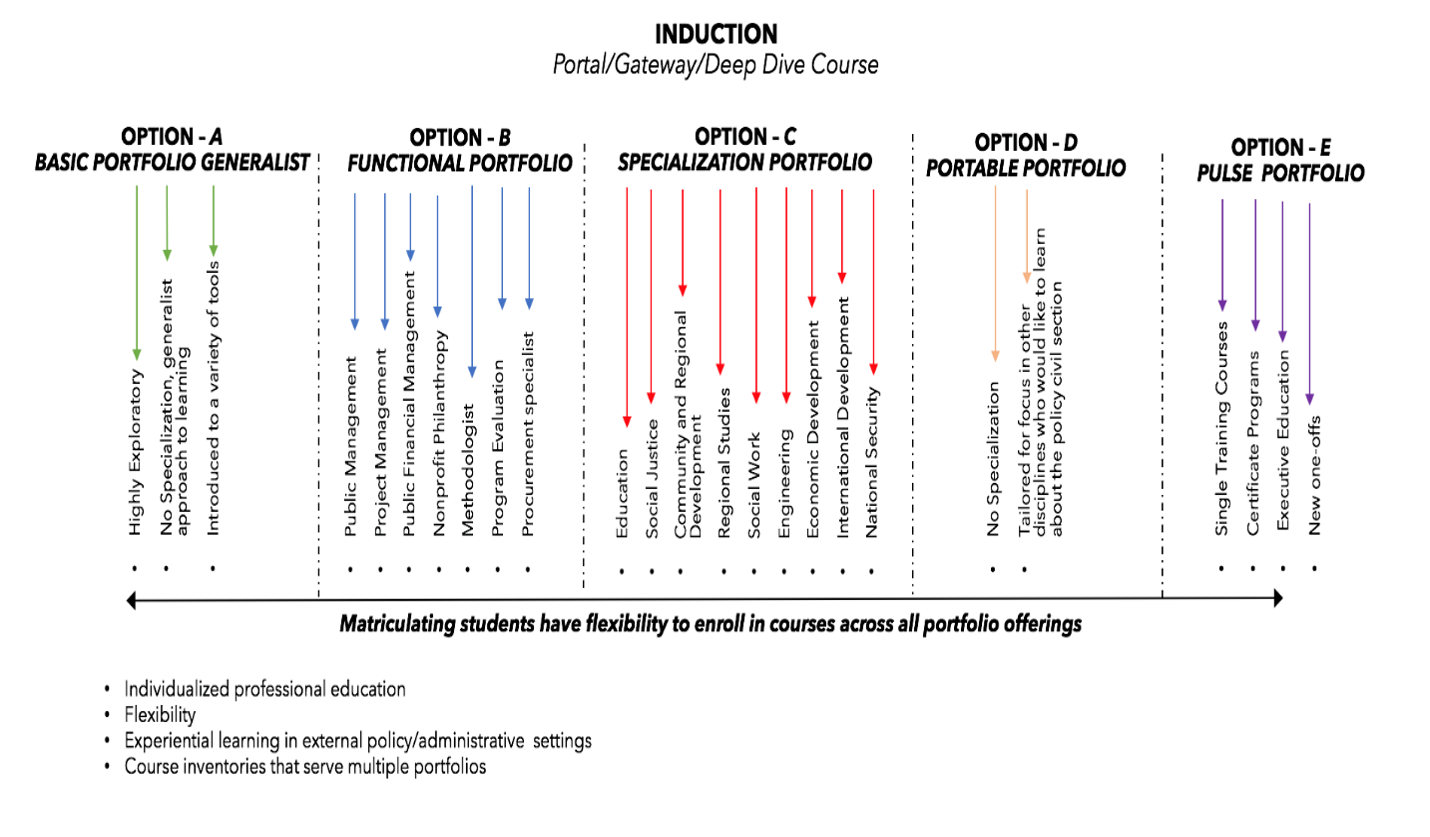
Making Agile Happen: Pre-Service - Part III

The next post in this series moves away from addressing agile competencies in the traditional masters’ program the subject of the prior post, and suggests the creation of a portfolio track approach for future programs that provide education on agility in government. Broadly speaking, five portfolio tracks would serve as the main set of offerings of new public affairs education. These tracks would share five attributes:
- course content and experiential activities will differ between and among the portfolios;
- course content and matriculation requirements will be developed and designed by faculty who teach in the track, faculty from other departments who can offer advice, and successful practitioners who currently serve in the areas of focus of specific portfolio tracks;
- students will mainly study with those in their same portfolio;
- course credits, timing, and assessment will vary based on the portfolio; and
- university administration will grant flexibility in the design and execution of courses and credit for faculty involvement.
Portfolio Track A: Range
Designed for students who want the flexibility to explore various disciplines and functions without specializing in any particular course of study, similar to existing programs that offer a “generalist” approach to curricular development. This portfolio track can be tailored to align most directly and strongly with the agile governance competencies, further refining and developing agile competencies seeded during the Induction phase discussed in the prior blog. Experiential learning settings would include public investigations, government initiatives and strategic planning, and intergovernmental coalitions.
Portfolio Track B: Role
Designed for students who want to have a particular role or position after graduation. Courses and experiences would focus on the knowledge and skills needed to succeed in operational positions in the public service arena, such as program management, public finance, risk management, cyber security, human resources, and program evaluation. Learning settings include governmental offices, public/private partnerships, public administrative offices, budget and finance offices.
Portfolio Track C: Issue
Designed for students who want to work in a particular policy/issue area. This portfolio exposes students to knowledge and tools addressing specific policy issues/disciplines. Settings involve experiential learning directly connected to the issue area, such as an energy think tank, water authority, or housing non-profit.
Portfolio Track D: Exploration
Designed to be a “portable” portfolio that schools of public affairs can offer to graduate students seeking advance degrees in discipline-specific areas, and who would like to understand how policy works and the mechanisms and tools used to engage with players in this community. For example, this portfolio would include classes on policy development, political communication, or writing for impact, and could be tailored for various clusters of disciplines: physical scientists, natural scientists, medicine, arts, or architects.
Portfolio Track E: Pulse
Designed to be a “pulse” portfolio that addresses unique individual interests. This portfolio would include:
- Certificate programs
- Weekend learning sessions
- Executive education
- Unique, one-off classes
The graphic below presents the portfolio concept. The dotted lines represent learning connections across the portfolios.
PORTFOLIO TRACKS: RANGE, ROLE, AND ISSUE
Matriculation for Portfolios A, B, and C
After successful completion of the Induction phase (discussed in the previous post, students would choose a particular portfolio in which to enroll. Students will take required foundational courses that develop competencies and build learning experiences aligned with the emphasis of the particular portfolio.
Portfolio Contents and Design:
Each of the A, B, and C portfolio tracks contains:
- Menus/pathways of curated courses designed specifically for that portfolio.
- Experiential learning requirements embedded in individual courses as well as separate, individual experiences. These take place off-campus at sites relevant to the nature of the portfolio. For example, if a student chooses portfolio B and the pathway is public management, then students would spend a significant amount of time in local, state, federal, non-profit agencies—and be exposed to strategic planning and operations (e.g., systems, human resource, and economic development). Experiential requirements are embedded on each pathway; integrated into each course within pathway and offered as separate modules (e.g. intermittent internships or shadowing). This requires formal collaborations with a variety of non-university entities (city, state, federal, non-profit, business), and provides options for apprenticeships that can involve breaks in matriculation.
- Course formats vary depending on their role in the pathway:
- Modules: courses composed of several discreet components that share a theme and can be taught by several professors.For example, a communications module can be composed of several parts covering different types of writings, social media, oral communications, and debate.
- Traditional Courses
- Pulse Courses:discreet short courses offered as part of the portfolio’s required learning.These can supplement other courses or offer introduce students to new concepts.
- One-offs: courses designed to cover content that holds immediate interest but does not fit neatly into a portfolio.These also can include pilot courses testing new materials, pedagogy, and professorial collaborations.
- Use of Technologies:given the extraordinary shifts educational institutions made in response to COVID-19 restrictions, multiple-media platforms can be used to construct coursework, broaden access to learners outside of the institution, collaborate across geographical boundaries, develop new course assessments, and engage with practitioners tackling real, immediate public administrators and public policy challenges.
- Course content will vary depending on the learning objectives.Content will be developed by school faculty in close consultation with expert practitioners in the public, non-profit and business sectors, and designed to achieve an integrated program for learning.
Matriculation for Portfolios D and E
These portfolio tracks are designed for those not ready to commit to professional graduate training in public affairs. The Tracks respond to either how public affairs impacts their work and profession (Portfolio D), or those not ready to commit full time to a graduate professional program but willing to take courses and earn credits that may be used in the future to enroll in a full-time program (Portfolio E).
Portfolio D: This portfolio would require the development of a basic course in public affairs offered to a wide range of audiences from students in other disciplines, community leaders, and members of the public. The course would include an understanding of public affairs settings, how policy is deliberated and administered, the data dimensions of policy, the role of intergovernmental governance, and citizen participation.
Portfolio E. This portfolio track can build upon extant programs that serve non-traditional masters students who cannot commit to full-time study. Program offerings in this portfolio can integrate agile governance competencies by designing specific content for each of these programs, or can allow those in this portfolio to enroll in courses offered in portfolios A, B, and C.
FINAL NOTE
Affecting changes discussed in this post will necessitate securing the interest and resources of a variety of players, including schools of public affairs, universities, foundations, associations, employers and potential enrollees. A commitment of this magnitude demands open minds and frank discussions. Those working on agile governance have built platforms, including the Agile Government Center within NAPA, upon which to have these discussions.
Next Post
As mentioned in this blog, the portfolio tracks foster participation from those currently engaged in the practice of public administration and policy. The next post will discuss ways that specific training on agile governance competencies can be offered to those in public service.
Links to all posts in this series:




